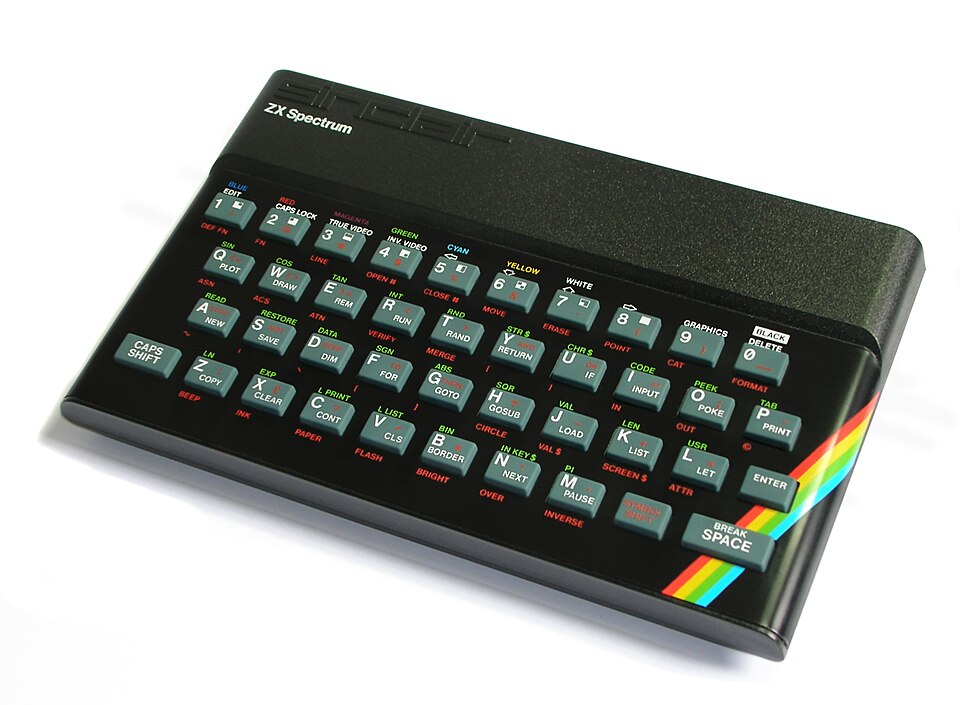The ZX Spectrum: A Deep Dive into a British Computing Icon
The ZX Spectrum is a legendary 8-bit home computer released in the United Kingdom in 1982 by Sinclair Research. It’s a machine that holds a huge place in the hearts of many, particularly in Britain and parts of Europe, and is considered a pivotal moment in the history of personal computing. Here’s a comprehensive look at it, covering its history, specs, impact, and legacy:
1. History & Development
- Sinclair’s Precursors: The Spectrum wasn’t Sinclair’s first foray into home computers. They previously released the ZX80 and ZX81, which were very affordable but also quite limited.
- Timex Sinclair Partnership: Sinclair partnered with Timex in the US to sell the ZX81 as the Timex Sinclair 1000. This experience helped Sinclair refine their designs and manufacturing.
- The Need for Color: The ZX81 was monochrome. The market was starting to demand color, and the Spectrum was Sinclair’s answer.
- Launch & Price: Launched on April 23, 1982, the ZX Spectrum 16K model retailed for £175 (roughly £600 today). This was significantly cheaper than its competitors like the Commodore 64 and Apple II, making it accessible to a wider audience.
- Later Models: Several revisions followed:
- ZX Spectrum 48K (1984): The most popular model, with increased memory. Became the standard.
- ZX Spectrum + (1984): Added a built-in interface for connecting peripherals.
- ZX Spectrum 128K (1986): Increased memory again and offered improved sound capabilities.
- ZX Spectrum +2 (1987): A redesigned model with a built-in floppy disk drive (though it was expensive).
- ZX Spectrum +3 (1987): Further refinements, but ultimately too late to compete with the emerging 16-bit machines.
2. Technical Specifications (ZX Spectrum 48K – the most common model)
- CPU: Zilog Z80A running at 3.5 MHz
- RAM: 48 Kilobytes (KB) – expandable with external memory packs
- ROM: 16 KB (containing the BASIC interpreter and operating system)
- Display:
- Resolution: 256 x 192 pixels
- Colors: 15 colors (8 bright, 7 dark) – though limited by attribute clash (see below)
- Sound: Single-channel AY-3-8912 sound chip (in later models like the 128K) or a simple “beeper” in earlier models.
- Keyboard: Rubber keys (early models) or a more conventional keyboard (later models). The rubber keys were notoriously unreliable.
- Storage: Cassette tape (standard), later models supported floppy disk drives.
- Ports: Edge connector for peripherals (joysticks, printers, etc.), cassette port, RF output for connecting to a TV.
3. Unique Characteristics & Limitations
- Attribute Clash: A major limitation of the Spectrum’s graphics. The screen was divided into 8×8 pixel blocks, each with its own color attribute. You couldn’t have multiple colors adjacent to each other within the same 8×8 block, leading to a blocky, often colorful but visually constrained look. Skilled programmers found ways to work around this limitation.
- Rubber Keys: The early Spectrum models had rubber keys, which were cheap to produce but often felt mushy and unreliable. They were a common source of frustration for users.
- BASIC Interpreter: The Spectrum came with a built-in BASIC interpreter, allowing users to write their own programs. It was a relatively simple BASIC, but powerful enough for many games and applications.
- Loading Times: Games and programs were typically loaded from cassette tape, which could take several minutes. This was a common annoyance.
- TV as Monitor: The Spectrum was designed to be connected to a standard television set, which served as its monitor.
4. Games & Software
The ZX Spectrum was hugely popular for its games. Thousands of titles were released, covering a wide range of genres. Some iconic games include:
- Jet Set Willy: A notoriously difficult platformer.
- Manic Miner: The predecessor to Jet Set Willy, also a challenging platformer.
- Chuckie Egg: A puzzle/platformer.
- Head Over Heels: An isometric adventure game.
- Elite: A groundbreaking space trading and combat simulator.
- Dizzy series: A popular series of adventure games.
- Rebelstar Raiders: A tactical RPG.
- Saboteur!: An early stealth action game.
Beyond games, the Spectrum also had a thriving software scene for:
- Word Processing: Programs like Wordcraft.
- Database Management: Programs for managing data.
- Educational Software: A wide range of educational titles.
- Programming Tools: Assemblers and other tools for advanced programming.
5. Impact & Legacy
- Democratization of Computing: The Spectrum’s affordability brought computing into many homes for the first time.
- British Game Development: It fostered a vibrant game development industry in the UK. Many successful game developers started their careers on the Spectrum.
- Programming Education: It inspired a generation to learn programming.
- Cultural Icon: The Spectrum became a cultural icon in Britain, representing the 1980s and the early days of home computing.
- Emulation & Revival: The Spectrum continues to be popular today through emulation. There’s a strong community of enthusiasts who still play and develop for the platform. The ZX Spectrum Next, a modern reimagining of the Spectrum, has been released to great acclaim.
- Influence on Later Systems: The Spectrum’s design and approach influenced later home computers and game consoles.
Resources for Further Exploration
- World of Spectrum: https://www.worldofspectrum.org/ – A massive database of Spectrum games and software.
- ZX Spectrum Next: https://www.specnext.com/ – Information about the modern ZX Spectrum Next.
- Wikipedia – ZX Spectrum: https://en.wikipedia.org/wiki/ZX_Spectrum
In conclusion, the ZX Spectrum was more than just a computer; it was a cultural phenomenon that shaped a generation and left an indelible mark on the history of computing. Its limitations often forced creativity, and its affordability made it accessible to a wide audience, fostering a vibrant community that continues to thrive today.
